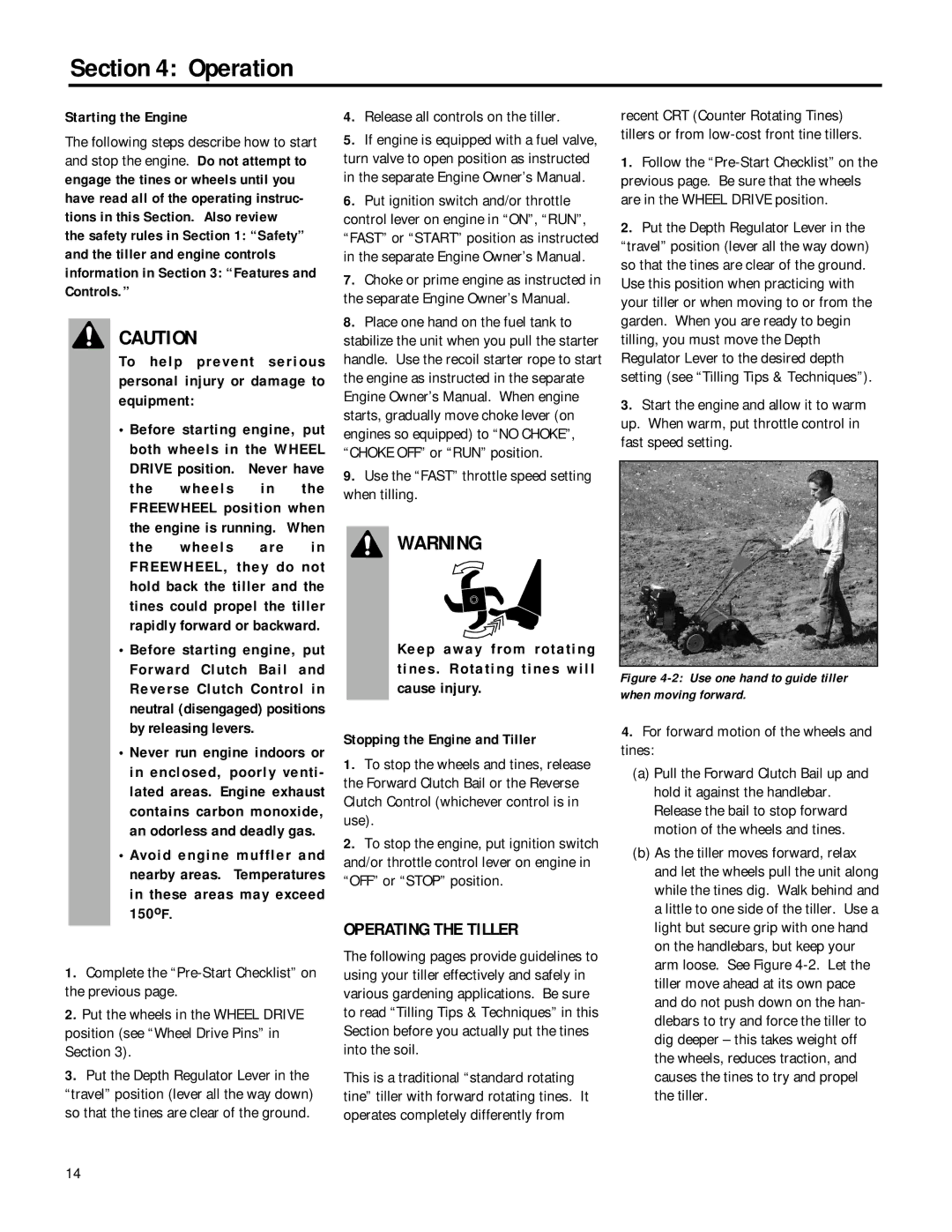
Section 4: Operation
Starting the Engine
The following steps describe how to start and stop the engine. Do not attempt to engage the tines or wheels until you have read all of the operating instruc- tions in this Section. Also review
the safety rules in Section 1: “Safety” and the tiller and engine controls information in Section 3: “Features and Controls.”
CAUTION
To help prevent serious personal injury or damage to equipment:
• Before starting engine, put | |
both wheels in the WHEEL | |
DRIVE position. | Never have |
the wheels | in the |
FREEWHEEL position when | |
the engine is running. When | |
4.Release all controls on the tiller.
5.If engine is equipped with a fuel valve, turn valve to open position as instructed in the separate Engine Owner’s Manual.
6.Put ignition switch and/or throttle control lever on engine in “ON”, “RUN”, “FAST” or “START” position as instructed in the separate Engine Owner’s Manual.
7.Choke or prime engine as instructed in the separate Engine Owner’s Manual.
8.Place one hand on the fuel tank to stabilize the unit when you pull the starter handle. Use the recoil starter rope to start the engine as instructed in the separate Engine Owner’s Manual. When engine starts, gradually move choke lever (on engines so equipped) to “NO CHOKE”, “CHOKE OFF” or “RUN” position.
9.Use the “FAST” throttle speed setting when tilling.
recent CRT (Counter Rotating Tines) tillers or from
1.Follow the
2.Put the Depth Regulator Lever in the
“travel” position (lever all the way down) so that the tines are clear of the ground. Use this position when practicing with your tiller or when moving to or from the garden. When you are ready to begin tilling, you must move the Depth Regulator Lever to the desired depth setting (see “Tilling Tips & Techniques”).
3.Start the engine and allow it to warm up. When warm, put throttle control in fast speed setting.
the | wheels | are | in |
FREEWHEEL, they do not | |||
hold back the tiller and the | |||
tines could propel the tiller | |||
rapidly forward or backward. | |||
• Before starting engine, put | |||
Forward Clutch | Bail | and | |
Reverse Clutch Control in | |||
neutral (disengaged) positions | |||
by releasing levers. |
|
| |
• Never run engine indoors or | |||
in enclosed, poorly venti- | |||
lated areas. Engine exhaust | |||
contains carbon monoxide, | |||
an odorless and deadly gas. | |||
• Avoid engine muffler and | |||
nearby areas. Temperatures | |||
in these areas may exceed | |||
150oF. |
|
|
|
1. Complete the | |||
the previous page. |
|
|
|
2. Put the wheels in the WHEEL DRIVE | |||
position (see “Wheel Drive Pins” in |
| ||
Section 3). |
|
|
|
3. Put the Depth Regulator Lever in the | |||
“travel” position (lever all the way down) so that the tines are clear of the ground.
WARNING
Keep away from rotating tines. Rotating tines will cause injury.
Stopping the Engine and Tiller
1.To stop the wheels and tines, release the Forward Clutch Bail or the Reverse Clutch Control (whichever control is in use).
2.To stop the engine, put ignition switch and/or throttle control lever on engine in “OFF” or “STOP” position.
OPERATING THE TILLER
The following pages provide guidelines to using your tiller effectively and safely in various gardening applications. Be sure to read “Tilling Tips & Techniques” in this Section before you actually put the tines into the soil.
This is a traditional “standard rotating tine” tiller with forward rotating tines. It operates completely differently from
Figure 4-2: Use one hand to guide tiller when moving forward.
4.For forward motion of the wheels and tines:
(a)Pull the Forward Clutch Bail up and hold it against the handlebar. Release the bail to stop forward motion of the wheels and tines.
(b)As the tiller moves forward, relax and let the wheels pull the unit along while the tines dig. Walk behind and a little to one side of the tiller. Use a light but secure grip with one hand on the handlebars, but keep your arm loose. See Figure
14
